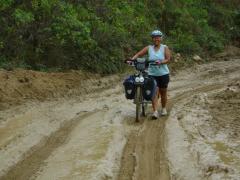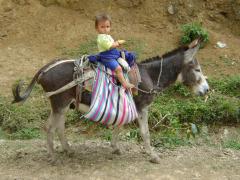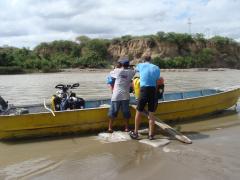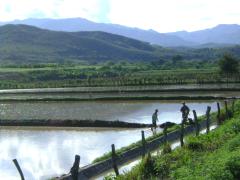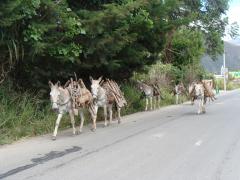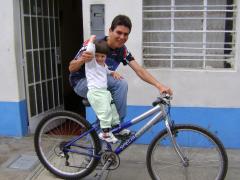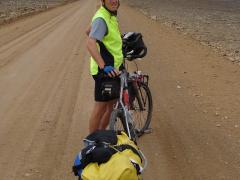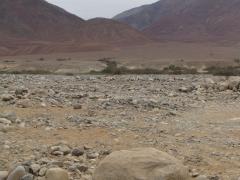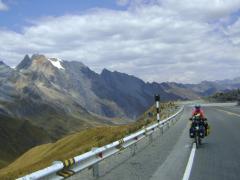Peru
Riding into Peru at La Balsa
We are now in Peru. Another country! This is the 11th country we have entered with our bikes. With something like 11,800 miles (19,000 kilometers) we crossed the Ecuador border into Peru at La Balsa. This was the quietest and most rural border crossing we have done to date. As the immigration officer stamped our paperwork, a chicken roamed the room pecking at crumbs, a herd of cows passed out front and the money changers sat on the bridge enjoying beer on this late Saturday. No one came up to us asking if we wanted to change our money from dollars (which they use in Ecuador) to Soles (Peru's currency). That was a first.
From the border we started off following a river and actually had a flat road for 7 kilometers. Yes flat. We heard that Peru is flatter then Ecuador but we could not believe it. Of course, we found out otherwise in the morning, as the road rose above the village of Namballe. The people were so friendly on our ride from Namballe to San Ignacio! We feel like rock stars once again. Everyone waves and beeps and everyone says hello and "welcome to Peru". We even got filmed by a couple passing by on motorcycles. He explained it is for marketing material promoting tourism in the town of San Ignacio. Along the route a young boy ran after us with two papayas in his hands to give us as a present. His name was Carlos and he had no shoes but he had a wonderful smile to go with his kindness. We have found the people much more outgoing and less intimidated than the reserved folks of the highlands of Ecuador. We like it when people think we are special. We make more contacts and find out more about the people we see along the way. read more here... lee mas aquí... »
Up the Utcubamba River Valley to the land of the Chachas
From San Ignacio we descended rapidly into a completely different kind of country - rice paddies everywhere. Neither of us had ever seen the cultivation of rice before, so we were amazed to see the effort required to work with the plants at the various parts of their life cycle. It was beautiful, too, but like we had left the high mountains and landed in a south-east Asian area!
After about 50 kilometers of dirt (formerly paved, but long since decayed) we hit beautiful new pavement for the first time in days. And it was downhill, too. But we soon turned off for a shortcut that we read about in Peter Berechree's incredible blog of his Andes-by-bike adventure. We took a dirt-road turnoff to the town of Bellavista and found our way to the banks of the Rio Marañon, a major river headed to the Amazon. Hoping that we'd gotten to the right place, we waved and yelled to a fellow cleaning his boat on the other side, he eventually came for us. We loaded the bikes up a 2x4 ramp and crossed over in a jiffy, then road a few miles to catch the highway again. We got a pleasant little diversion from the highway and probably eliminated 50 kilometers from our route. read more here... lee mas aquí... »
Mountains and People: Perceptions of Northern Peru
Peru has some of the biggest mountains and deepest valleys we have encountered so far. We find it very interesting to ride the high mountains of Peru because the sierras are inhabited by indigenous people who live in the traditional ways they have maintained for centuries. Not much has changed in hundreds of years. In some areas we have been riding through there is no electricity, no running water, no paved road, lots of sheep, cows, chickens, donkeys which carry cargoes of milk, wood, heavy loads of vegetables like potatoes, corn and cabbage. The people themselves carry huge loads on their backs. The women wear the same traditional clothes they have for ages including special hats which identify the area they come from. Around Cajamarca the women wear short skirts with ballooning petticoats, tall, wide-brimmed hand-woven hats made of fine strands of straw. They all have wraps and ponchos to either keep warm or carry a load. They're even shorter than me. From the distance they sometimes remind me of the profile of Halloween witch The women in Northern Peru can be seen herding donkeys loaded with metal containers of milk, babies on their backs and walking along a high mountain road while spinning wool on a stick, preparing the wool for knitting or weaving. The women always have busy hands. Always. Where we are right now the women knit afghans of multiple colors, ponchos, and sweaters. If they don't have a baby on their backs they're carrying a load of firewood, twigs, or huge bunches of herbs and greens. read more here... lee mas aquí... »
Peru Route: July 13 to October 9, 2008
Here is our route in Peru.
Each day has elevation profile, map, and GPS information.
Other recommended information sources::
- We used the trip notes from 2bike.be,(at the bottom of the page) which are quite detailed and very useful. They include total elevation and what shops and hospedajes are found along the way.
- PDFs of daily route notes from Florian and Rebekkah are gems of information. These are rehashes of a set that has been carried by many cyclists.
- Also, Pius and Stefan of panamerica.ch have done a great job with more consolidated elevation profiles than we show here. Take a look at their Peru map page and study their route profiles in PDF format. They took our same route from Trujillo to Bolivia.
- Maps: We used the Rough Guide Map of Peru most of the time, and thought it was pretty decent. ITMB also has a map, and Lima2000 has a pretty decent map that you can get within the country.
- GPS: The free routeable GPS maps at perut.org have been recommended highly. Also, Guiacalles.com in Lima has a full GPS map for sale.
Skip to:
Ecuador border to Cajamarca
The route we took is difficult and opened only in 2000 or so, so most cycle tourists seem to go the Panamerican Highway from Loja, Ecuador to Trujillo, Peru. This is fairly fast, but they all hate it. On the contrary, we really loved the mountainous way we went, even though it's challenging.
From the border there is a gentle but long climb of 1300 meters and then a descent into San Ignacio. It's mostly downhill then to the valley of the Rio Marañon at just 400 meters of elevation. We took a turnoff and went through Bella Vista instead of staying on the main road through Jaen. This saved many kilometers and was a pretty pleasant (dirt) road cutoff. We took a small ferry across the river just beyond Bella Vista.
After returning to the highway and getting to Bagua Grande, we started the beautiful climb up the Rio Utcubamba to Pedro Ruiz. Because of road construction we had to take a combi from the intersection there to Chachapoyas. Then lovely dirt road to El Tingo (Kuelap) and Leymebamba. From Leymebamba to Celendín is a huge climb and drop to the Rio Marañon again; we did it in a potato truck. Then from Celendín to Cajamarca is one pass - there is pavement on the Cajamarca side. We took a bus from Cajamarca to Trujillo.

| Ride | date | miles/km | Elev ft/mt |
|---|---|---|---|
| Namballe, Peru to San Ignacio, Peru | 2008-07-13 | 28/45 | 4300/1327 |
| San Ignacio to Tamborada | 2008-07-16 | 45/73 | 1650/509 |
| Tamborada to Bagua Grande via Bella Vista | 2008-07-17 | 43/69 | 2034/628 |
| Bagua Grande to Pedro Ruiz and by combi to Chachapoyas | 2008-07-18 | 42/68 | 3600/1111 |
| Chachapoyas to El Tingo | 2008-07-19 | 23/37 | 518/160 |
| El Tingo to Kuélap by car | 2008-07-20 | 1/2 | 4000/1235 |
| El Tingo to Leymebamba via Revash | 2008-07-21 | 35/56 | 2332/720 |
| Leymebamba to Celendín by potato truck | 2008-07-22 | 89/144 | /0 |
| Celendín to Cruz Conga | 2008-07-23 | 21/34 | 2539/784 |
| Cruz Conga to Cajamarca, Peru | 2008-07-24 | 47/76 | 2122/655 |
Trujillo to Huancayo
The route from Trujillo to Huancayo is pretty standard (and fairly difficult) for bike tourists. You ride a little ways south on the Pan American Highway to 15km south of Chao, then turn into a private road, climb up to the Cañon del Pato, up to Huaraz, then either through the national park or around the paved road and over a 4700 meter pass, then through several ups and downs until Huánuco. From Huanuco it's pavement up and over Cerro de Pasco then to Huancayo. There´s an excellent elevation profile on panamerica.ch showing this stretch.| Ride | date | miles/km | Elev ft/mt |
|---|---|---|---|
| Cajamarca to Trujillo (by bus) | 2008-07-26 | 1/2 | /0 |
| Trujillo to Chao, Peru | 2008-08-16 | 42/68 | 1456/449 |
| Chao to Chuquicara | 2008-08-17 | 46/74 | 2500/772 |
| Chuquicara to Camp 8km before Yuracmarca | 2008-08-18 | 30/48 | 2063/637 |
| Camp near Yuracmarca to Huallanca, Peru | 2008-08-19 | 13/21 | 1794/554 |
| Huallanca to Caraz, Peru | 2008-08-20 | 25/40 | 2700/833 |
| Caraz to Huaraz, Peru | 2008-08-22 | 43/69 | 3600/1111 |
| Huaraz to Cátac, Peru | 2008-08-24 | 23/37 | 1800/556 |
| Catac to Conococha | 2008-08-25 | 29/47 | 2237/690 |
| Conococha to Pachapaqui | 2008-08-26 | 25/40 | 1978/610 |
| Pachapaqui to Huallanca, Huánuco, Peru | 2008-08-27 | 30/48 | 2405/742 |
| Huallanca (Huánuco) to La Unión | 2008-08-28 | 13/21 | 190/59 |
| La Unión to Tingo Chico | 2008-08-30 | 20/32 | 1204/372 |
| Tingo Chico to Chavinillo | 2008-08-31 | 23/37 | 2270/701 |
| Chavinillo to Huánuco, Peru | 2008-09-01 | 45/73 | 1787/552 |
| Huánuco to Huariaca | 2008-09-04 | 43/69 | 3667/1132 |
| Huariaca to Huancayo by car and bus | 2008-09-05 | 1/2 | /0 |
Huancayo to Lake Titicaca and the Bolivian Border
From Huancayo we took the dirt road through the canyon (Rio Mantaro) for 5 days to Ayacucho. Many people take the partly paved route over a high pass to Huancavelica instead. From Ayacucho we took a bus to Cusco - the dirt road from Ayacucho to Abancay is very difficult, and we were tired. From Cuzco there's just one pass and it's easy, then mostly things are flat to the Bolivian border. All paved, sometimes smooth and sometimes not.Take a look at the excellent elevation profiles for this section on panamerica.ch (only to cusco).
| Ride | date | miles/km | Elev ft/mt |
|---|---|---|---|
| Huancayo to Mariscal Cáceres | 2008-09-13 | 49/79 | 2700/833 |
| Mariscal Cáceres to Camp before Anco | 2008-09-14 | 41/66 | 2083/643 |
| Camp near Anco to Mayocc | 2008-09-15 | 27/44 | 1456/449 |
| Mayocc to Huanta, Peru | 2008-09-16 | 20/32 | 2047/632 |
| Huanta to Ayacucho, Peru | 2008-09-17 | 30/48 | 2381/735 |
| Ayacucho to Andahualas by bus | 2008-09-21 | 1/2 | /0 |
| Andahuaylas to Cuzco by bus | 2008-09-22 | 1/2 | /0 |
| Cuzco to Quiquijana | 2008-09-29 | 44/71 | 485/150 |
| Quiquijana to Sicuani | 2008-09-30 | 44/71 | 1824/563 |
| Sicuani to Santa Rosa | 2008-10-01 | 42/68 | 2677/826 |
| Santa Rosa to Calapuja | 2008-10-02 | 71/115 | 593/183 |
| Calapuja to Puno, Peru | 2008-10-03 | 44/71 | 869/268 |
| Puno to Ilave | 2008-10-07 | 35/56 | 1410/435 |
| Ilave to Yunguyo | 2008-10-08 | 49/79 | 2033/627 |
| Yunguyo, Peru to Copacabana, Bolivia | 2008-10-09 | 7/11 | 528/163 |
Lucho and the Casa de Ciclistas in Trujillo, Peru
When we came down from the mountains of Peru to the coast we stayed at the fabled Casa de Ciclistas (House of Cyclists) in Trujillo, Peru. Lucho Ramirez started offering his simple house to passing touring cyclists clear back in 1984, and is on the edge of crossing the one thousand mark. One thousand groups of cyclists have signed his journal and stayed there over almost 25 years! One cyclist stayed a year! Many stay far longer than they expect to, often for a week or more. It's a delight to browse through the journals and see famous cyclists that we've either met or heard of who passed this way. Our friends Dick and Els, from Holland, signed the book about 5 years ago. Our friend Andrew signed it just a month or so ago. Our friends Pat and Cat also passed through about 3 years ago.
Many of you have asked us if we're setting some kind of a record or something, and the answer is no, we're really slow, and lots and lots of people have gone farther. Although not all the cyclists who have stopped at Lucho's house were doing rides as big as ours, many were doing rides much bigger. One fellow, Hans Stuecke, has been cycling for 46 years!
Anyway, Lucho provides a tremendously friendly place for cyclists stop, recharge, get their equipment worked on, and generally have a wonderful memory. We left our bikes safely there for our trip home, and came back to find them waiting for us. read more here... lee mas aquí... »
Cyclists before us at the Casa de Ciclistas
People often ask us "Has anyone ever done this before?" or "Are you setting a new Guinness Record?". The answer, of course, is an authoritative NO! We know this, of course, but stopping at the Casa de Ciclistas in Trujillo and looking through the logs makes us really feel humble. We were the 998th entry over 24 years. Plenty of people have been through here! There are slow people and fast, many rides as long as ours, but many much longer. Here are a few links and a few details about some of the folks who have signed their names in the logs at Trujillo.
- Hans Stuecke
- Hans has been bike touring for 46 years, and has visited at least 193 countries. He really HAS set a Guinness record. I don't think we're going to touch his record anytime soon!
- Dominic Gill
- Dominic started his ride about the same time as we did, and we actually met him for a few moments in Whitehorse, Yukon Territory. But Dominic just finished riding a tandem (most of the time by himself, alone) with gear for himself and a guest, all the way from Alaska to Patagonia. His gear weight was incredible, but his idea was "Take a Seat". He invited anybody who wanted to to come along for a ride for as long as they wanted. He had incredible experiences.
Randy switches to a BOB trailer... Advantages and Disadvantages
When we came back to Peru I started riding with a Ibex BOB trailer trailer again instead of using panniers as I have for the last few years. It was kind of a return to my roots, since I used a BOB for our first several rides in 2001-2005. So far, I'm happy to be pulling my old friend Bob again. It feels good on the bike.
You may not know it, but since the BOB was introduced, US touring cyclists have often raged at each other about its advantages and disadvantages. As one who has used both the pannier system (front and back racks with saddlebags attached to them) and the BOB, a single-wheeled bike trailer, I thought I could weigh in on advantages and disadvantages.
- I think when you ride with the BOB it's more like riding a bike and less like driving a truck, which is how I feel when riding with panniers.
- The BOB is a bit easier on the bike, since there's one more wheel to spread out the load. The frame of the bike gets almost no strain (and it can get quite a bit going over bumps with the panniers). The rear axle still gets about half the load, but the frame itself gets almost nothing.
- My kickstand doesn't work any more! In general, it's just harder to manage the bike+bob configuration when you're off the bike. I think it's easier to manage when you're riding, but harder when you're off.
Back on the road, Climbing up into the mountains
Click here for all of our favorite photos from this section
After more than three weeks of not riding we are back on the road once again in Peru. We made a two-week trip back to the United States to see all our family members and are glad to report all are well. It was good to see the family as well it was a delight to see all our wonderful friends.
We returned to Trujillo, Peru and stayed once again at the Casa de Ciclistas where Lucho and his family have offered free hospitality to cyclist for 23 years. Randy and I were visitor 998. While staying there, we meet 7 different cyclists from all over the world.
We have now been on the road for 5 days and are taking a rest day in Caraz. The ride from the coast up to Caraz has been amazing, spectacular, a hard ride on mostly dirt road, some good and some awful. The best part is the lack of traffic which permitted us to enjoy the majestic views of the mountains and the river valley we pedalled through.
We rode for one day on the Panamerican highway south to Chao. The road had a good shoulder, big trucks and a landscape which brought to mind the sand dunes of Saudi Arabia. Huge hills, not really mountains, of nothing but sand dunes. Nothing lived in this region, no houses, no people, no business thrived, no birds chirped, no butterfly fluttered by. read more here... lee mas aquí... »
Our highest point yet: 15,400 feet (4700 meters)
Today we crossed the highest point of our journey so far, and perhaps the highest of the trip. After climbing back up into the Andes (the Cordillera Blanca) for more than a week, we crossed over 15,400 foot (4700 meter) Abra Yana Shalla. We had been working our way up to this, climbing no more than 1000 meters per day as we got into the really high places. Nancy really felt the altitude in a number of ways, so we were trying to be as careful as possible. But we made the last push this morning up into the barren peaks. We saw lots of beautiful scenery in the last few days and will try to get the pictures uploaded within a few days.
Nancy's Poem: Climbing over the top
Crawling my way up the highest peak,
I wonder if I can do this.
Can I ride my bike up to the heavens?
Or will I die, will my heart give out,
Will I fall off the edge from the lack of oxygen?
I adjust my height of seat
I mount my metal steed
I pedal up the gentle grade,
I take a breath, I gulp another
I want more but the air resists
I chew some coca, I spit out the spines
Round the pedals turn, ever so slowly
My eyes start to burn, my lungs fight
Focusing on the ground ahead,
Listening to my music
Progress is being made,
My vision becomes smaller
My focus sharpens
Making it to the top is my only thought
I miss the sheep dogs attacking,
Three come from nowhere,
The charge shocks me back to reality
I dismount rapidly in fright
My bike protects me from the circling dogs
I throw a rock at the alpha dog
They back away, they retreat
A 4-year-old child chases them
With a bigger rock then mine,
Gracias, niño,
I crawl my way up to the top,
I fight, I want to cry
No, too much energy
My nose is running wild,
Drule pores from my mouth
As I gasp for another breath,
I leave it, to much energy to fix.
I stop for a rest I have resisted,
The air all seems blue,
Sounds and space is distorted
I wonder if I know
Can I count?
What is my birthday?
What is 4 plus 4
It all comes so slowly
I have to go on.
I yell to myself
Pay attention
No crying,
Get on with it
Obediently I pedal on read more here... lee mas aquí... »

